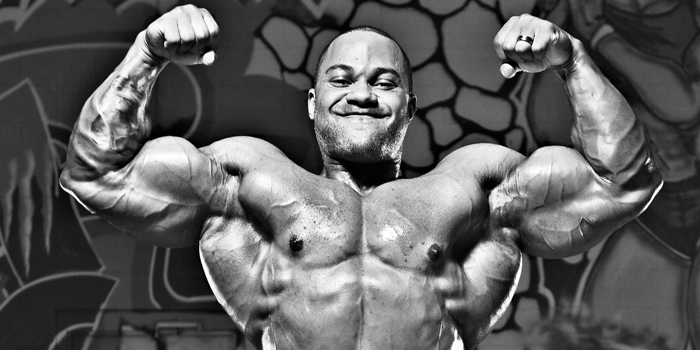
Bodybuilding books and magazines are filled with techniques to help lifters build more muscle.
Drop sets, super sets, extended sets, rest-pause sets, etc. — all help the lifter push past the pain barrier and create more tension (or inflict more damage) on the working muscle.
Now, most of these techniques have very little carry-over to strength training, which is why you don’t see many powerlifters supersetting 800-pound squats with leg extensions.
But an undersized powerlifter could still use these techniques during the off-season to increase the size of his quads. Just so the delineation is clear — high rep, high volume “bodybuilding” work is for size, not strength.
However, some classic powerlifting techniques used to build strength can also build size. In fact, with just a few tweaks, some are every bit as effective as the classic bodybuilding tools.
Here are eight maximal techniques that can be easily modified to suit a bodybuilder’s needs — namely build serious muscle.
If you’re a bodybuilder who has never used maximal techniques (please note, I’m using the word “maximal” in the general sense — technically these are submaximal methods) then watch out. The intensity may cripple your “4 sets of 10” ass for days after the workout. Be careful. Start slow and train smart.
To help avoid too much unnecessary shocking, each technique will be ranked from 1 to 5.
1 means that any lifter can try it, even raw beginners.
2 or 3 is better suited to more experienced lifters.
4 or 5 is strictly for experienced bodybuilders or guys with decades of training and need a serious shock to get growing again.
The Dividing Line
Since the start, bodybuilders have typically divided into one of two camps:
- Technique Guys – Those who focus on the quality of each rep and maintaining a strict “mind-muscle” connection. Perfect form, peak contractions, constant tension/ no lockout reps. Think Arnold Schwarzenegger in Pumping Iron, or Ben Pakulski in Generation Iron.
- Heavy Load Guys — Those who care only about moving as much weight as possible. Forget range of motion or slow tempos, just hang and bang and load the fucking bar! Think Ronnie Coleman or Branch Warren in Generation Iron.
Let’s compare two modern day examples, Ben Pakulski and Branch Warren.
They’re both top-level pros, massive and muscular. In other words, they’re both on the far right side of the genetic curve.They’re both financially capable of training as their full time job. They both have unlimited access to top-notch nutrition and supplementation.
Yet their training styles couldn’t be more different. And both men are elite level pros.
WATCH Leg Training with IFBB Pro Ken Jackson
Which begs the question: is one style even better at all?
I argue that the answer is no. What matters is how well the body tolerates the training (certainly an older bodybuilder may not be able to hang and bang like a younger one) and how fun it is.
In other words, some dudes love heavy training and as such get results from it. Others love pumping up and the volume.
These classic powerlifting techniques are more suited to the heavy, hanging and banging crowd. But if you’re a hardcore pump artist, that means you should pay special attention, cause what you’ll read could just add pounds of “free” muscle to your frame.
1. Do Light Stuff First (Experience Level = 1)
Today everyone does these dynamic warm-ups. I’m sure there are big and strong guys that do them. I don’t know any, though. In my experience, limited as that may be compared to some, warming up is best accomplished by a series of light special exercises before the workout begins.
For example, before a Max Effort bench workout, I used to do light reverse grip dumbbell presses. This would warm up the biceps tendon and get some blood into the shoulders.
Now we're not talking huge work here — just two or three sets of 15 reps with 15-pound dumbbells. The idea isn’t to get a pump or “pre-fatigue” anything; it’s to prime the musculature for the upcoming movement.
For a hypertrophy-loving bodybuilder, when your nervous system is primed, you can use more weight. Which means create more muscle damage, and therefore build more muscle.
So on an upper body day, I’d do a series of DB presses, lateral raises, band pulls, and face pulls. On a lower body day it would be hanging leg raises, standing pulldown abs, and glute-ham raises. Just enough to wake shit up, not enough to cause even a hint of fatigue.
For pure bodybuilding I’d take this one step further – I’d do my heaviest, “biggest” lift last in the workout. That means a chest day might start with dumbbell presses, flyes, and machine presses before ending with flat bench presses. It’s not only safer; it’s much better from a hypertrophy perspective.
Sample Warm Up Movements
2. Maximal Concentrics (Experience Level = 2)
Doing lifts where the eccentric portion is reduced or eliminated completely allows you to safely target the concentric range with very heavy loads.
Sample exercises would include pin pulls, pulls off blocks or mats, and suspended good mornings.
Now while a powerlifter might use double or triples, a bodybuilder should work in the 3-5 rep range. The safest way would be to progressively add weight each set in the 3-5 rep range before going for one balls-out set of 3-5 killer reps. Taking it one notch further, you can go 100% balls out and challenge yourself to do as many reps as you can.
The combination of heavy loads and increased time under tension creates a serious hypertrophic response.
Sample Uses Maximal Concentrics
3. Maximal Isometrics (Experience Level = 3)
These are often called “quasi isometrics.” Bodybuilding is all about controlling the eccentric and concentric portion of the rep, with little attention paid to isometric work.
An isometric rep is one performed where the weight doesn’t move despite maximum force being applied. As such, they typically require a power rack and work very well with pin pulls.
I like to set up for pin pulls with a heavy load and perform four touch-and-go “primer” reps before pulling one all-out rep against the pins for at least five seconds. So it’s 5,4,3,2 and then 1 killer rep where you basically try to fling the rack across the gym.
Sample Use of Maximal Isometrics
The Last Set Pin Pulls with Iso's
4. Restricted Range Reps (Experience Level = 3)
These can be applied to pushes (pin presses, floor presses), pulls (rack pulls), and squats (high box squats). By working in a restricted range (the stronger range) you can overload the muscle more and create more damage in that portion of the ROM while getting the nervous system accustomed to moving heavy loads.
Sets lasting 18-25 seconds are best.
Obviously attention must be made to also work the weaker points on the ROM to prevent imbalances from occurring.
Sample Use of Restricted Range Reps
5. Maximal Eccentrics (Experience Level = 5)
I struggled with whether to include this. When most bodybuilders hear “max eccentrics” they think of a high school kid slowly lowering 405 onto his chest while his buddies cheer him on.
That shit is useless.
The best way to train this is through plyometrics, as a proper maximum eccentric should never be slower than the concentric portion.
Think about it: no sport involves a slow eccentric. It’s always explosive to allow force to be absorbed and then generated.
That’s why band work is so effective — it allows you to accelerate through the eccentric.
Sample Uses of Maximal Eccentrics
6. Reverse Bands (experience level = 3)
I’ve written extensively about reverse bands here. The best exercises for bodybuilders are reverse band squats and reverse band bench presses. Bands allow the bodybuilder to use greater resistance than normal as they help considerably in the concentric phase, without the use of a partner (the much abused forced reps).
This technique is also very easy on the joints, making it a favorite for older bodybuilders who still love to lift heavy.
Sample Uses of Reverse Bands
- SS Yoke Squat Reverse Band Squats
- Reverse Band Bench Pressing with Shoulder Saver Pad
- Reverse Band Hack Squats
7. Accommodating Resistance (experience level = 3)
The most basic forms of accommodating resistance (for a bodybuilder) are chains and bands. This is also an area of much confusion, so here’s a cheat sheet:
Chains are “easier” on the body as they deload onto the floor. They also strip off easier.
Bands are slightly more “advanced” as they deload into the body. As such, they tend to wear you out a bit faster. They’re also extremely powerful.
For a bodybuilder looking to add mass, the best way to use chains is to work “below and above” your max.
Let’s say your max squat is 405 x 5. Load a bar up with 315 and add five 20-pound chains per side.
Since the chains deload at the bottom, you’d only have 315 pounds on your back in the hole, but 515 at the top.
This is a powerful training tool that can quickly shoot up a squat, as it teaches how to support more weight on your back when you’re strongest, while greatly reducing fatigue where you’re weak (while 515 is a lot of weight at lockout, 315 in the hole is a lot lighter than 405). It also greatly reduces momentum and reinforces technique, something that can mess up many intermediate squatters.
A cool “intensity” technique to add both size and strength to your squat is to work up to 50% of your max squat weight, and then start adding a chain per side to the bar doing sets of 8. Keep adding chains until you reach your 8-rep max. Now start taking one chain off per side each set, while bumping up the reps by 2. So 8 reps, then 10, then 12, then 14.
This adds tremendous volume while completely altering the strength curve. Get your puke bucket ready.
Sample Uses and Variations of Accommodating Resistance
8. Cheating (Experience Level = 2)
This is the most hotly criticized yet widely performed intensity technique of all. Anybody who’s ever lifted a weight has performed cheat reps, whether it’s performing an extra 2 or 3 “ugly reps” at the end of a set or swinging a heavy barbell from rep one, a la Arnold’s cheat curls.
Cheat reps have been around since the first days of bodybuilding. It was a popular way to train back in the 40s and 50’s, way before the notion of “peak contraction” was dreamed up, and long before steroids came on the scene. So only a fool would dismiss it outright.
However, a smart rule is cheat reps should never start a set, only extend it, after at least a few near perfect quality reps have been performed. And cheat reps shouldn’t be used for all exercises, just the safer ones. So barbell curls are in, preacher curls and flyes are out.
When you first pick up a weight, you aren’t a bodybuilder or a powerlifter – you’re just another guy in the weight room.
But as you progress in your journey, you’ll find fellow bros increasingly segregating themselves, and as a result, avoiding dozens of exercises or techniques because they’re “powerlifting” and not classic “bodybuilding.”
They’re missing out. A true master borrows from all related disciplines, taking what he needs to reach his goals while keeping the rest in the back of his playbook.
But not discarded entirely, and never forgotten. Cause you never know. Like all things in life, lifting goals can change.
Photos courtesy of Jeffrey Sygo at www.symiphotography.com

















Regards John